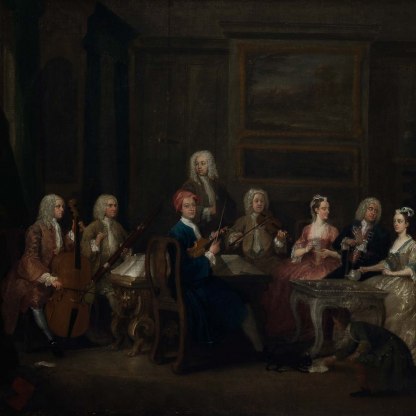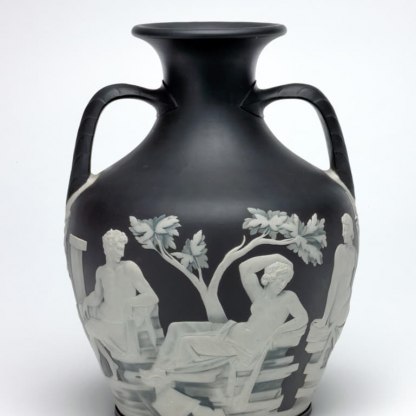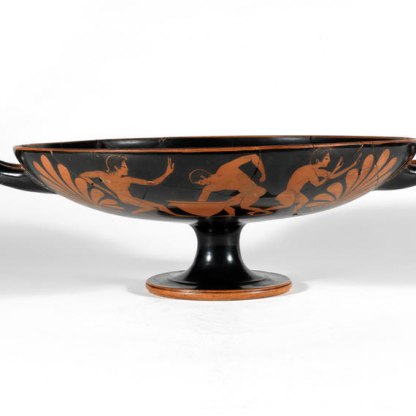Teapot

The pale cream colour and the Wedgwood mark on the bottom of this teapot identify it as an example of Queensware from the late 1770s, so named after Queen Charlotte, the wife of George III, who had ordered a tea set made from the material in the 1760s.
This royal commission provided a considerable boost to Josiah Wedgwood's growing business, for earthenware was not the first choice of material for the manufacture of tea-making vessels in the eighteenth century. Chinese porcelain, red stoneware and silver were all considered more elegant and were more suitable for tea due to their greater resistance to heat. In a letter of 1767, the potter marvelled at his own success: 'It is really amazing how the use of it [Queensware] has spread almost over the whole Globe, and how universally it is liked.'
The fine pedigree of Queensware and the decoration on the vessel here both suggest how popular tea was in the most elevated social circles in the eighteenth century. By the time this teapot was made, however, the beverage was no longer simply the preserve of the wealthy. Jonas Hanway, writing in 1756, noted with some distaste how widespread tea drinking had become among the lower classes:
There is a certain lane in Richmond where beggars are often seen, in the summer season, drinking their tea. You may see labourers who are mending the roads drinking their tea; it is even drank in cinder-carts; and what is no less absurd, sold out of cups to hay-makers.
The couple who appear on the side of this teapot are considerably more refined than the labourers by whom Hanway had been so affronted. Seated on a bench in a pleasant garden, the gentleman gestures with his right hand while in his left he holds a small teacup and saucer. Next to him sits an elegantly dressed woman, her spoon held above her own cup. Neither vessel has a handle, in imitation of Chinese and Japanese porcelain cups. Handles became common on teacups only gradually after 1750. Saucers, a Western innovation, were introduced in around 1700.
Before the couple a table is spread with the essentials of a civilised tea party: a milk jug, a sugar bowl with tongs, a tray for the pot – or possibly a spoon tray – and a larger tray to carry it all on. To the couple's left, at a distance, a black servant fills a teapot from a large kettle.
This scene called The Tea Party and that of The Shepherd on the other side of the pot, were popular designs that Wedgwood had used since the 1760s, when he had first started sending his wares to the factory of John Sadler and Guy Green in Liverpool. Here, decoration could be printed directly onto the glaze. This was a new technique that allowed the rapidly growing demand for decorated tea vessels to be met quickly and cheaply. Printed Queensware was affordable to those tea lovers for whom painted pottery or porcelain was prohibitively expensive.
Themes and periods
Data from our collections database
Pale cream-coloured earthenware (Queen's ware) printed onglaze in black with on one side, The Tea Party , and on the other, The Shepherd.
Pale cream-coloured earthenware (Queen's ware) printed onglaze in black. Globular with leaf-wrapped spout, double entwined handle with rounded foliate terminals and close-fitting circular cover surmounted by a flower finial. Decorated on one side with 'The Tea Party', showing a fashionable couple seated beside a tea table in a garden attended by a black servant; on the other with 'The Shepherd', and on the cover with two floral sprays.
Purchased from the Misses Kingsland at Croydon in April 1903 for £2.5.0 (45/-); Dr J.W.L. Gaisher, FRS.
Legal notes
Dr J.W.L. Glaisher Bequest
Acquisition and important dates
- Method of acquisition: Bequeathed
- Dates: 1928-12-07
Dating
Made by Josiah Wedgwood's factory and sent to Liverpool to be printed by Guy Green
- George III
- Production date: circa AD 1780 : The pale cream coloured body suggests a date of about 1780.
Maker(s)
- Wedgwood, Josiah Factory
- Green, Guy Printer
Note
Made by Josiah Wedgwood's factory and sent to Liverpool to be printed by Guy Green
Place(s) associated
- Etruria
- Liverpool
Materials used in production
Read more about this recordStories, Contexts and Themes
Other highlight objects you might like
Suggested Curating Cambridge products
Sign up to our emails
Be the first to hear about our news, exhibitions, events and more…






